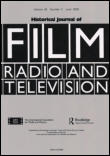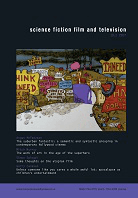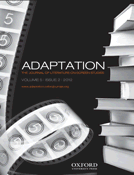
HISTORICAL JOURNAL OF FILM RADIO AND TELEVISION
Scope & Guideline
Connecting the Dots Between Media and Cultural Heritage
Introduction
Aims and Scopes
- Historical Analysis of Media:
The journal emphasizes the historical dimension of film, radio, and television, investigating how these mediums have influenced societal narratives and how historical events have been portrayed through them. - Transnational Perspectives:
A consistent theme in the journal's publications is the exploration of media across national boundaries, highlighting how cultural exchange and global influences shape media narratives. - Cultural and Ideological Critique:
The journal often engages with critical theories to analyze the ideological implications of media representations, examining issues such as race, gender, and political propaganda. - Technological Evolution of Media:
A significant focus is placed on the technological advancements in film, radio, and television, exploring how these changes affect production, distribution, and reception. - Audience Reception Studies:
The journal investigates how different audiences interact with and interpret media texts, including studies on fandom, cultural memory, and the impact of media on public perceptions.
Trending and Emerging
- Intersectionality in Media Studies:
There is a rising trend in examining the intersectionality of identity categories such as race, gender, and sexuality within media representations, reflecting broader societal conversations about inclusivity. - Impact of Digital Media:
The influence of digital technologies on film, radio, and television is increasingly prominent, with studies exploring how digital platforms reshape production practices and audience engagement. - Documentary and Non-Fiction Media:
The journal is seeing a surge in interest in documentary filmmaking and non-fiction media as tools for historical representation and social commentary, reflecting their growing significance in contemporary discourse. - Archival Studies and Preservation:
Emerging themes include the importance of archival work and the preservation of media history, emphasizing the need to safeguard diverse media legacies for future scholarship. - Global Film Studies:
There is a noticeable shift towards global film studies, with increased attention to non-Western cinema and transnational collaborations, highlighting the interconnectedness of global media practices.
Declining or Waning
- Traditional Film Criticism:
There has been a noticeable reduction in articles centered on traditional film criticism, as the journal increasingly prioritizes interdisciplinary approaches that integrate historical, cultural, and technological perspectives. - National Cinema Studies:
While there are still discussions on cinema within national contexts, the prominence of national cinema studies appears to be waning in favor of more transnational and global analyses. - Focus on Classical Hollywood:
The exploration of classical Hollywood narratives and star systems is becoming less frequent, as the journal diversifies its attention to include more contemporary and international cinema. - Static Historical Narratives:
There is a decline in straightforward historical accounts of film and media, with an increasing shift towards dynamic analyses that incorporate theory and contemporary relevance.
Similar Journals

Nauka Televideniya-The Art and Science of Television
Advancing Knowledge in the Evolving World of TelevisionNauka Televideniya - The Art and Science of Television is an esteemed academic journal dedicated to the interdisciplinary exploration of television as a medium and its impact on culture, society, and technology. Published by the GUMANITARNII INST TELEVIDENIYA & RADIOVESCHANIYA IMENI M A LITOVCHINA-GITR, this journal has been committed to open access since 2010, ensuring that valuable research is freely available to a global audience. With an ISSN of 1994-9529 and an E-ISSN of 2587-9782, "Nauka Televideniya" serves as a vital platform for scholars, researchers, and students to share innovative findings, theoretical advancements, and practical applications relevant to the television industry. Articles published cover a wide array of topics, including media studies, communication theory, and technological advancements shaping the future of television. The journal's mission is to foster discourse that enhances understanding of the television medium's role in shaping human experience; a critical endeavor in an age where audiovisual media permeates daily life.

FILM CRITICISM
Redefining Perspectives on CinemaFILM CRITICISM is a prestigious open-access journal dedicated to the study and review of cinema, offering a platform for scholars, critics, and students to engage deeply with the evolving landscape of film. Published by Film Criticism and based in the United States at Allegheny College, this journal has been contributing to film studies since 2002, with recent issues spanning from 2023 to 2024. Registered under ISSN 0163-5069, it is recognized in the Visual Arts and Performing Arts categories, achieving a commendable rank of #372 out of 667 in Scopus, placing it in the 44th percentile of its field. With an open-access policy implemented since 2016, FILM CRITICISM not only broadens accessibility to scholarly work but also enhances the dialogue around cinematic narratives, theories, and critiques. The journal's relevance is underscored by its current Q3 ranking, making it an essential resource for researchers and professionals alike who are invested in the critical examination of film.

Science Fiction Film and Television
Charting New Worlds in Film and Television ScholarshipScience Fiction Film and Television, published by LIVERPOOL UNIV PRESS, is a leading academic journal that explores the rich intersection of science fiction with cinematic and television narratives. With an ISSN of 1754-3770 and E-ISSN 1754-3789, this journal provides a platform for critically engaging with both historical and contemporary works within the genre, offering insights into its cultural significance, aesthetic innovations, and societal impacts. As part of the communication and visual arts fields, it is recognized in the Scopus ranking, achieving an impressive percentile of 87th in Visual Arts and Performing Arts, and maintaining a respectable rank within communication studies. Since its inception in 2018, it aims to foster dialogues among scholars, professionals, and students, making substantial contributions to the understanding of science fiction as a vital cultural phenomenon. With access options that cater to a broad audience, Science Fiction Film and Television is essential reading for those interested in exploring the innovative potentials and narratives of science fiction across media.

Area Abierta
Empowering Research with Unrestricted AccessArea Abierta is a prominent scholarly journal dedicated to the exploration and dissemination of research in the fields of social sciences and education. Published by the Universidad Complutense de Madrid, this journal has embraced an Open Access model since 2001, allowing for unrestricted access to its diverse array of articles and enhancing the visibility of research findings globally. With a commitment to fostering academic discourse and innovation, Area Abierta serves as an essential resource for researchers, professionals, and students alike, providing a platform for critical insights and studies that contribute to ongoing advancements in its scope. The journal's alignment with rigorous academic standards and its role in the scholarly community underline its significance in promoting accessible knowledge and collaborative learning.

Adaptation-The Journal of Literature on Screen Studies
Bridging Literature and Screen: A Scholarly Journey.Adaptation: The Journal of Literature on Screen Studies, published by Oxford University Press, stands at the forefront of interdisciplinary scholarship, blending the realms of literature, visual arts, and performing arts. This esteemed journal addresses the evolving relationship between literature and its adaptation into various screen formats, providing a vital platform for researchers, professionals, and students interested in the adaptation process across different media. With a commendable 2023 impact factor reflected by its recognition in the Q1 quartile categories for Literature and Literary Theory as well as Visual Arts and Performing Arts, it ranks in the top tiers of its field, showcasing its influence and reach. The journal is dedicated to exploring theoretical and practical approaches to adaptation, ensuring that voices from diverse perspectives are heard. Although it operates under traditional access models, the insights offered in its publications are invaluable for those looking to deepen their understanding of how literature translates into screen narratives. With coverage spanning from 2010 to 2024, Adaptation continues to be a pivotal reference point for innovative scholarship and critical discourse.

Television & New Media
Illuminating the Evolution of Media in Modern SocietyTelevision & New Media is a leading academic journal dedicated to the exploration of the intricate relationships between television, new media technologies, and contemporary culture. Published by SAGE Publications Inc, this journal boasts an impressive impact factor, placing it in the prestigious Q1 category for both Cultural Studies and Visual Arts and Performing Arts as of 2023. Its high rankings in Scopus—#8 in Visual Arts and Performing Arts and #24 in Cultural Studies—underscore its significance in the academic community, reflecting its robust contribution to the discourse on media and culture. Spanning from 2000 to 2024, the journal features cutting-edge research that offers insights into the evolving dynamics of media and its societal implications, making it an essential resource for researchers, professionals, and students alike. Although currently not open access, the journal ensures that its contents are accessible through academic libraries, facilitating the dissemination of knowledge in an ever-changing digital landscape.

Journal of Radio & Audio Media
Advancing Research in Radio & Audio DynamicsThe Journal of Radio & Audio Media, published by Routledge Journals, Taylor & Francis Ltd, serves as a premier platform for research in the dynamic fields of radio and audio media studies. With a strong focus on innovative communication practices, this journal plays a vital role in shaping the discourse surrounding audio media, particularly in light of rapidly evolving technologies and cultural contexts. Holding a prestigious Q2 ranking in the Communication category and positioned within the 68th percentile among Social Sciences Communication journals in Scopus, it consistently showcases high-quality research that contributes to both academic knowledge and industry practice. Covering a diverse range of topics from audio production and podcasting to radio policy and audience studies, the journal encourages interdisciplinary collaboration and engagement. Although Open Access options are not available, the Journal of Radio & Audio Media remains committed to accessibility through educational initiatives and partnerships. Researchers, professionals, and students alike will find valuable insights and inspiration within its pages as they explore the influential power of audio in contemporary society.

Music Sound and the Moving Image
Engaging Scholars in the Art of Sound and SightMusic Sound and the Moving Image is an esteemed journal published by Liverpool University Press, focusing on the intricate relationships between music, sound, and the moving image. Since its inception, the journal has aimed to foster a multidisciplinary discourse, engaging scholars and practitioners across the fields of musicology, media studies, and visual arts. With an ISSN of 1753-0768 and an E-ISSN of 1753-0776, it has solidified its presence in the academic community, evidenced by its diverse impact reflected in Scopus rankings, including Rank #63/180 in Music and Percentile 65th. The journal's classification in Q3 for Music and its active coverage from 2018 to 2024 enhances its relevance, making it a pivotal resource for researchers and creators who explore the dynamic interplay of sound and imagery. Although currently not available as Open Access, the journal offers a robust platform for peer-reviewed articles, contributing to the advancement of knowledge in this rapidly evolving field.

New Review of Film and Television Studies
Exploring the Intersection of Media and SocietyNew Review of Film and Television Studies, published by Routledge Journals, Taylor & Francis Ltd, stands as a vital platform for scholars and practitioners engaged in the dynamic fields of film and television studies within the United Kingdom. This journal, which has been in circulation since 2010 and will continue through 2024, provides a rigorous academic forum for contemporary research, critical analysis, and innovative discourse surrounding visual storytelling. With an impressive Scopus rank placing it in the 66th percentile for Visual Arts and Performing Arts, and a respectable Q2 categorization, the journal fosters an interdisciplinary approach, bridging communication and cultural studies. While the journal does not currently operate under an open access model, it remains an invaluable resource for researchers, students, and professionals aiming to understand and influence the evolving landscape of film and television in our digital age. As it navigates the intersection of media and society, New Review of Film and Television Studies is essential reading for those looking to advance their knowledge and contribute to the ongoing scholarly conversation.

Transnational Screens
Advancing Interdisciplinary Dialogues on Global Artistic PracticesTransnational Screens is a premier academic journal published by Taylor & Francis Ltd, focusing on the dynamic intersections of visual arts, performing arts, and communication in a globalized context. Since its inception, the journal has garnered significant recognition, featuring in the Q1 category for Visual Arts and Performing Arts and Q3 for Communication as of 2023, reflecting its influential contributions to these fields. With a Scopus ranking placing it in the 78th percentile in Visual Arts and Performing Arts, this journal serves as a vital platform for researchers, professionals, and students aiming to explore the implications of transnational narratives in contemporary media and artistic practices. The journal is accessible to a diverse readership and promotes open dialogue through its commitment to publishing innovative and interdisciplinary research from 2020 to 2024. As a key resource for understanding the complexities of transnational screens, it invites submissions that push the boundaries of traditional scholarship and engage with pressing global issues through the lens of the visual and performing arts.